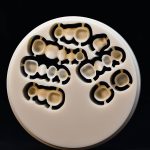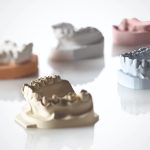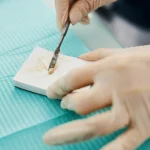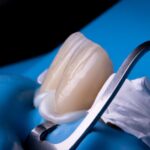
Composite resin cements are now the solution of choice for the adhesive cementation of indirect restorations thanks to their superior mechanical, adhesive and aesthetic properties compared to conventional cements.
These materials are characterised by a resin matrix based on methacrylic monomers reinforced by inorganic filling particles, which provide strength, hardness and dimensional stability over time (1,2).
Their versatility allows bonding to various substrates – enamel, dentin, ceramics, metals and composite materials – making them suitable for a wide range of clinical applications (3,4). However, the choice of cement type and adhesion protocol remains crucial for long-term clinical success.
The introduction of universal dual-curing resin cements (light-curing and self-curing) in the dental market has led to increasingly simplified cementation systems in order to standardise the cementation procedure, which is complex and dependent on the operating technique (5).
However, some of them present chemical incompatibilities with some universal adhesives (6), leading companies to produce systems consisting of resin adhesives together with self-adhesive cements, which can be used individually or together (7).
In this sense, a new division of resin cements into three categories (7) has been proposed: (1) multi-step adhesives; (2) one-step self-adhesives; (3) universal (one-step or multi-step depending on the clinical protocol).
Multi-step adhesive cements
Multi-step adhesive cements were the first resin cements introduced on the dental market and require the usual steps for adhesion to dental tissue – etching (15-30 seconds depending on whether dentine or enamel is involved), priming the dentine and application of the bonding agent (bonding) (8).
Multi-step adhesive cements have shown higher adhesion values to dentin than self-adhesive cements, both initially and after ageing; (9) characteristics that are clearly evident in the case of cementation of partial restorations (10) but not in the case of fully covered crowns in zirconia or lithium disilicate (11).
However, compared to self-adhesive cements, multi-step adhesive cements, if used in combination with “etch and wash” systems, may expose the patient to post-operative sensitivity, usually transient and destined to resolve within a few days or weeks after cementation (12).
One-step self-adhesive cements
Research and development in the field of dental materials have allowed the introduction of “one-step” self-adhesive cements which no longer require the usual procedures of pre-adhesion to the dental tissue (13). These self-etching resin cements contain modified methacrylate monomers with acids such as phosphoric acid on their side chains (8).
These, in turn, have an etching effect and can bind to the calcium in the dental tissue (7). However, it has been demonstrated that resin cements that involve multiple steps and phases guarantee higher tensile strength values than one-step self-adhesive cements (9).
From a clinical point of view, this is relevant only in cases of partial preparations, presence of enamel and short abutments (14). Furthermore, it is necessary to pre-treat some materials such as composite or ceramic with silane agents, such as 10-MDP for zirconia.
Universal cements
Then there are the so-called “universal cements”, which have the following characteristics (7):
- They bind to various substrates, dental tissues and metallic, resin and ceramic restorative materials;
- They can be used both in multi-step and one-step mode, similarly to adhesive cements (self-etching, which require selective etching on the enamel or etch & wash adhesive systems) and self-adhesive depending on the clinical case and the dentist’s preferences (7);
- They are dual (both light-curing and self-curing);
- Either the cement itself or its possibly associated adhesive system can contain etching acids and silane molecules to create chemical bonds between different substrates;
- They can be combined with primers or bonding agents to improve adhesion on different substrates, without the need for other priming systems.
These cements have a lower hardness than the other two categories of resin cements and a greater tendency to absorb water, making them more susceptible to ageing (15).
Light-cured and dual-cured cements: Advantages and limitations compared
Most of these three types of cements are dual-polymerised, i.e. self-curing and light-curing. Light-curing cements are less widespread due to the risk of incomplete polymerisation under non-translucent prostheses. They are therefore used almost exclusively for the cementation of veneers of glass ceramic (16).
Light-curing cements, with initiators based on camphorquinone and aliphatic amines, are less subject to chromatic changes than chemically polymerized cements, based on aromatic amines and benzoyl peroxide (17).
Some light-cured cements also exhibit a higher level of conversion and microhardness than dual-cured ones, probably due to different polymerization kinetics and differences in the composition and type of filler (18). However, the mechanical and polymerization properties of resin cements are strongly dependent on the type of resin polymer (19), so no generalisable conclusions can be made.
How to choose a resin cement
The clinical performance of resin cements is however influenced by multiple factors, including the chemical composition, the type of substrate, the clinical conditions and the application technique.
An in-depth knowledge of the different types of cements, their characteristics and indications, allows the clinician to select the most suitable material for the specific context, optimising the effectiveness of the treatment and reducing the risk of prosthetic failure.
Despite the progress made, there remain many opportunities for development and improvement in this constantly evolving field.
References:
- Breschi L, et al. Materiali e tecnologie odontostomatologiche. (2011): 95-117.
- Simionato F. Tecnologie dei materiali dentali. 1.2, 1.2,. Padova: Piccin; 1985.
- Grande F, Carossa M, Balma A, Scotti N, Mussano F, Catapano S. Influence of Thickness and Thermocycling on Tensile Strength of Two Resin-Based Cements Used for Overdenture Bar-Type Attachments: An In Vitro Study. Int J Prosthodont. 2023 Sep 20;
- Mehl C, Harder S, Steiner M, Vollrath O, Kern M. Influence of cement film thickness on the retention of implant-retained crowns. J Prosthodont. 2013 Dec;22(8):618–25.
- Shafiei F, Fattah Z, Barati S. Effect of operator skill on the dentin bonding ability of a self-adhesive resin cement after different adhesive treatments. Gen Dent. 2019;67(5):e1–6.
- Suh BI, Feng L, Pashley DH, Tay FR. Factors contributing to the incompatibility between simplified-step adhesives and chemically-cured or dual-cured composites. Part III. Effect of acidic resin monomers. J Adhes Dent. 2003;5(4):267–82.
- Maravić T, Mazzitelli C, Mancuso E, Del Bianco F, Josić U, Cadenaro M, et al. Resin composite cements: Current status and a novel classification proposal. J Esthet Restor Dent. 2023 Oct;35(7):1085–97.
- Anusavice KJ, Shen C, Rawls HR. Phillips’ science of dental materials. 12th edition. Elsevier Health Sciences; 2012. 492–494 p.
- Miotti LL, Follak AC, Montagner AF, Pozzobon RT, da Silveira BL, Susin AH. Is Conventional Resin Cement Adhesive Performance to Dentin Better Than Self-adhesive? A Systematic Review and Meta-Analysis of Laboratory Studies. Oper Dent. 2020 Sep 1;45(5):484–95.
- Vogl V, Hiller KA, Buchalla W, Federlin M, Schmalz G. Controlled, prospective, randomized, clinical split-mouth evaluation of partial ceramic crowns luted with a new, universal adhesive system/resin cement: results after 18 months. Clin Oral Investig. 2016 Dec;20(9):2481–92.
- Maroulakos G, Thompson GA, Kontogiorgos ED. Effect of cement type on the clinical performance and complications of zirconia and lithium disilicate tooth-supported crowns: A systematic review. Report of the Committee on Research in Fixed Prosthodontics of the American Academy of Fixed Prosthodontics. J Prosthet Dent. 2019 May;121(5):754–65.
- Josic U, Sebold M, Lins RBE, Savovic J, Mazzitelli C, Maravic T, et al. Does immediate dentin sealing influence postoperative sensitivity in teeth restored with indirect restorations? A systematic review and meta-analysis. J Esthet Restor Dent. 2022 Jan;34(1):55–64.
- Wang L, Chen F, Yang F, Hoshika S, Yamauti M, Liu Y, et al. Bioactive Two-step Approach: Promising Bonding Strategy for a One-step Self-etch Universal Adhesive. J Adhes Dent. 2019;21(5):413–21.
- Alghauli MA, Alqutaibi AY, Wille S, Kern M. Clinical reliability of self-adhesive luting resins compared to other adhesive procedures: A systematic review and meta-analysis. J Dent. 2023 Feb;129:104394.
- Aldhafyan M, Silikas N, Watts DC. Influence of curing modes on monomer elution, sorption and solubility of dual-cure resin-cements. Dent Mater. 2022 Jun;38(6):978–88.
- Ortensi L, Vitali T, Bonfiglioli R, Grande F. New Tricks in the Preparation Design for Prosthetic Ceramic Laminate Veeners. Prosthesis. 2019 Oct 30;1(1):29–40.
- Almeida JR, Schmitt GU, Kaizer MR, Boscato N, Moraes RR. Resin-based luting agents and color stability of bonded ceramic veneers. J Prosthet Dent. 2015 Aug;114(2):272–7.
- Salgado VE, Albuquerque PPAC, Cavalcante LM, Pfeifer CS, Moraes RR, Schneider LFJ. Influence of photoinitiator system and nanofiller size on the optical properties and cure efficiency of model composites. Dent Mater. 2014 Oct;30(10):e264-271.
- Pereira SG, Fulgêncio R, Nunes TG, Toledano M, Osorio R, Carvalho RM. Effect of curing protocol on the polymerization of dual-cured resin cements. Dent Mater. 2010 Jul;26(7):710–8.
Would you like more information about Zhermack Dental products and solutions?
Contact us




 Zhermack SpA has been one of the most important producers and international distributors of alginates, gypsums and silicone compounds for the dental sector for over 40 years. It has also developed solutions for the industrial and wellbeing sectors.
Zhermack SpA - Via Bovazecchino, 100 - 45021 Badia Polesine (RO), Italy.
Zhermack SpA has been one of the most important producers and international distributors of alginates, gypsums and silicone compounds for the dental sector for over 40 years. It has also developed solutions for the industrial and wellbeing sectors.
Zhermack SpA - Via Bovazecchino, 100 - 45021 Badia Polesine (RO), Italy.


